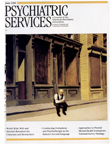Depression among aging persons with schizophrenia who live in the community
Abstract
OBJECTIVES: The study used the social antecedent model of depression in later life proposed by Linda K. George to develop a multifactorial model of predictors of depression among aging persons with schizophrenia living in the community. METHODS: The SHORT-CARE and the Network Analysis Profile, along with supplemental items, were administered to 117 outpatients age 55 and older who received DSM-III-R diagnoses of schizophrenia before age 45. Bivariate and multivariate analyses examined associations between 27 variables derived from George's model and the presence of depression. A cutoff score for the depression scale of the SHORT-CARE was used to detect clinically significant depression. RESULTS: Forty-four percent of the sample had probable pervasive depression. Bivariate analysis indicated that 16 variables were significantly associated with depression, and logistic regression showed that six variables were strong predictors. Depression was associated with the presence of positive symptoms, physical limitations interfering with activities, younger age, diminished linkage of members of the social network, lower income, and a smaller proportion of social network members who provided sustenance such as food and money. An 11-variable model correctly classified 81 percent of cases. CONCLUSIONS: The level of depression among older outpatients with schizophrenia is approximately one and a half to three times the level in the general older population. Depression in this patient group is associated with nonclinical variables that are independent of psychoses and that resemble patterns found among general older populations. Several of the variables are potentially alterable and therefore afford opportunities to enhance the well-being of persons with schizophrenia who live in the community.
Access content
To read the fulltext, please use one of the options below to sign in or purchase access.- Personal login
- Institutional Login
- Sign in via OpenAthens
- Register for access
-
Please login/register if you wish to pair your device and check access availability.
Not a subscriber?
PsychiatryOnline subscription options offer access to the DSM-5 library, books, journals, CME, and patient resources. This all-in-one virtual library provides psychiatrists and mental health professionals with key resources for diagnosis, treatment, research, and professional development.
Need more help? PsychiatryOnline Customer Service may be reached by emailing [email protected] or by calling 800-368-5777 (in the U.S.) or 703-907-7322 (outside the U.S.).



